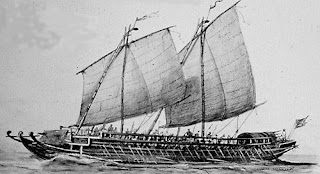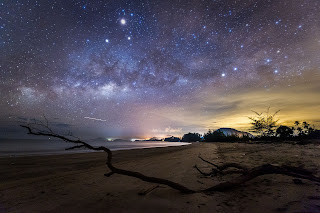We have been taught that 'Singapore' got its name from the native Malay name for the country, Singapura, which was in turn derived from Sanskrit which means 'Lion City'. Singa comes from the word siṃha(सिंह), which means "lion", and pūra (पुर) which means "city". This is also based on folklore as well as written records in the Malay Annals where a strange looking animal (possibly a lion) was sighted by Sang Nila Utama (a.k.a. Sri Tri Buana) when he was hunting in Temasek around 1299. He is said to have changed the name Temasek to Singapura based on this encounter. This etymology is also backed by the possibility that it may relate to similar use of the “lion” prefix in the Champa kingdom of
Simhapura or perhaps the Javanese kingdom of
Singhasari.
The
Malay Annals (1612) describes the beast seen by Sang Nila Utama as a powerful, fast-moving and fine-looking animal with a "red body, black head, and white breast", and size "slightly bigger than a goat." It could have been a tiger. Then again, it is unlikely that Sang Nila Utama or his followers would not recognise a tiger to mistake it for a lion.
Scholars have pointed out that lions are not native to Singapore or South East Asia, and the "lion" therefore would have been an error in identification and perhaps a folk or false etymology. See:
False etymology - Wikipedia.
While I do agree that 'Pura' means city, old maps never refer to "Siṃha", “Singha” or "Singa". Carta del Cantino's 1502 map shows the southern portion of the Malay peninsula being described as “Barxingaparaa'':
Also see Martin Waldaeemuller's 1513 map which shows the area as 'Bargimgapara':
Bargimgapara' or 'barxingaparaa' is said to be a corruption of "Bahr-Sincapura", where the word 'bahr' is Arabic or Persian for coastal kingdom or a large body of water.
Jan Huygen van Linschoten in his 1596 map described it as ‘Sincapura’:
Manuel Godinho de Erédia in his 1604 map described it as ‘Sincapvra’.
Captain Alexander Hamilton (1688-1733) said that around 1703, he rejected Johor Sultan’s gift of the island of Singapore. In his 1727 book "A New Account of East Indies", Hamilton describes 'Sincapure' as follows:
See also a 1748 book by Giovanni Botero which describes it as “Sincapvra”:
It is even pronounced similar to "Sinca" in various Chinese dialects. Wu: "sin ka phu", Gan: "sin-ka-po", Hakka & Southern Min: "Sîn-kâ-phô", & Mandarin: "Xīnjiāpō".
Thus it has always been "Sinca" and not "Singa".
So what does 'Sinca' means?
The word "Sinca" relates to the act of ritual purification i.e. sprinkling blessed or holy water as described in the Mahayana Sutra known as "Usnisa Vijaya Dharani Sutra" (Purifying All Evil Paths). To practitioners, the mantra (Dharani), in particular, is considered powerful for removing karmic obstacles, eliminating disasters and calamities, fulfilling wishes, benefit all beings and helps to cure illnesses. The transliteration from the Usnisa Vijaya Dharani Sutra states "Tathagata Sinca Me Samasvasayantu. Sarva Tathagata Samasvasa". I believe the word 'Sinca' or 'Sin-cha' ( सिञ्चत ) is synonymous with the entire purification act. It is used perhaps like what is currently retained in the Malay culture of "Merenjis" (minus the recitation of the Mahayana Sutra of course). See Picture of the act of sprinkling rose water on a Boeing 747-200.

In this sense, I believe that the etymology or rather toponymy of ‘Singapore’ relates closely to mainland Johor. This is so as around the 10th and 11th century mainland Johor was known by contextually-similar names i.e. "Ganggayu" or "Gangga Ayu" (Sanskrit meaning "water from river Ganges" i.e. holy water), and subsequently "Wura-wari" (old Javanese meaning "blessed, clear or pure water"). The ancient names of mainland Johor as well as Singapore could therefore relate to ritual purification practised by both Hinduism and Buddism. Both were practised by the native Malays in the southern Malay peninsula during Srivijaya rule (7th-13th century) and the subsequent Majapahit rule (13th-14th century).
 |
| Locals and tourists bathing in holy spring water at the Hindu temple in Bali, Pura Tirta Empul. |
Thus the etymology of the word ‘Singapore’ could possibly be attributed to its old name “Sincapura” which in Sanskrit means a city which has been sprinkled with blessed water i.e. “Purified City” or “Pure Land”.







































.jpg)